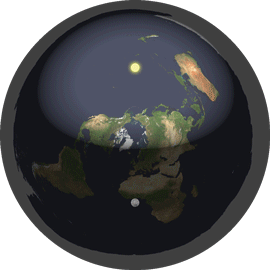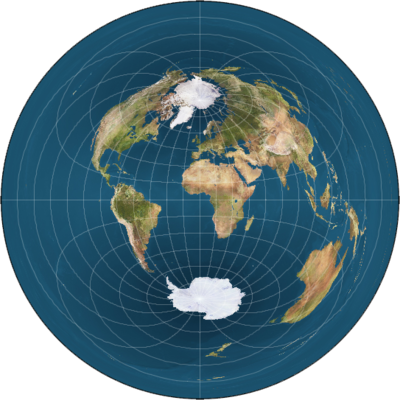First, let me say this site is fantastic. Who doesn't like a little nutty conspiracy theory once in awhile. I have a feeling that 90% of the supposed FE supporters are actually just faking it for fun or to encourage critical thinking. I do worry about the other 10% who are suffering from delusional paranoia.
I read the Wiki and there are some very glaring facts that blow this "theory" out of the water.
Lets hear them.
The sun and planets. So FET says the Sun is roughly 3000 miles away and is only 32 miles across. A few things. 32 miles is not large enough to create enough gravitational pressure to initiate fusion in hydrogen gas. (and we do know what the sun is burning because of its spectral lines) You lack the mass.What planarists are saying the sun gets all of its energy from complete inner nuclear fusion in this model?
Here's a paper pointing out an external source of high energy particles:
http://www.journalcra.com/article/external-energy-supply-sun-overwhelmingly-obvious-and-has-recently-been-detected-space-probe . There is also the hypothesis held by Eric Dollard the the sun gets its energy by converting it from elsewhere. A favorite hypothesis of mine regarding this (not one I hold to personally) is that the sun is a spherical vacuum with a concentration of physical aether around it due to a previous rush that created a vacuum and aether rushed together equidistantly to form a sphere, constantly burning because of the aether filling the entire universe. By aether, I am referring to this:
https://wiki.tfes.org/AetherIdeas may exist all over, can't assume planarists must accept nuclear fusion. It's alright to say "we don't know" as well.
The planets are small and orbit the sun a couple thousand miles away. If this is true, why has no group of intrepid FETers launched a mission to these tiny planets to prove to the world that the Earth is flat? I think we all know that answer to that one.Yeah, we know, because they are not able to do so. Instead, we rely on observation with what we can do.
Your model of sunlight is verifiable incorrect. If the Earth is laid out as proposed, some locations in the east would still be in daylight, while areas southwest would be in the dark. A simple phone call between two people, one positioned southwest of another could prove that the Earth is illuminated by this "flashlight" sun. Why hasn't this very easy, inexpensive test been done??? Again, we know the answer.Look at this carefully:
 Edge continent that keeps the air in. LOL, hard not to laugh when typing that. Where is this 50K foot tall wall of rock or ice surrounding this flat expanse of land?? Surely it could be mapped by a simple mission.
Edge continent that keeps the air in. LOL, hard not to laugh when typing that. Where is this 50K foot tall wall of rock or ice surrounding this flat expanse of land?? Surely it could be mapped by a simple mission.How far would the large ice wall be? Is it attainable? Details like that make all the difference here. Assuming it must be able to be mapped by some simple Antarctic mission or it must not be true is a fallacious assumption to make.
Also, the theory about dark energy holding in the air is completely false. Dark energy and matter are named that because they DON'T INTERACT with normal matter. It wouldn't be dark energy if it was holding all the air in. lol Maybe you should figure out what the hypothesis is first before trying to make a rebuttal attempt.
An alternative theory says that the atmolayer is held in by a complex reaction to the streams of Dark Energy at the edge of the world. This creates a "boundary" containment.
The Dark Energy Field is a vector field. It has a gradient that is smallest at the interaction of the atmosphere and the field, called the boundary layer. The DEF interacts with the magnetic field of the earth at this boundary layer. These vectors produce a force vector that is orthogonal to the other vectors in four dimensional space. This force vector is always normal to the boundary layer, thus providing a type of forced containment for the atmosphere.
- TheEngineer-https://wiki.tfes.org/Atmolayer
It is not physically blocking air, it consists of a force vector by the DEF and magnetic field interacting to create a forced containment normal to the boundary layer. Force vectors do not mean that specified fields involved are directly interacting physically.
Also, you sound like you know exactly what dark energy is, funny, even mainstream science admits they don't know.
Consider this as well:
https://wiki.tfes.org/Atmolayer_Lip_HypothesisThe atmoplane fading away slowly, and it need not be physically infinite either.
There are many other obvious problems with FET - what causes this acceleration that gives the illusion of gravityTrue, wouldn't exactly know for sure. Dark Energy, Aether, or infinite plane gravitation, they are in the end, not conclusive, but we are free to question and have models, that is the great part.
why don't the sun, moon, and planets simply crash into the Earth?Possibly because they are accelerating too, or, they are kept up by a force, such as electromagnetic levitation (a force acting against the 1G force). I really like the aetheric whirlpool hypothesis, sun, moon, stars, and planets move with the rotating whirlpool while in freefall due to the siphon nature of the whirlpool.
I could go on - magnetism without a metallic core,Does it need a literal center core? No, not required for magnetic fields.
the seaborne radar problem,The wiki happens to have an entry on this:
https://wiki.tfes.org/Radar_and_the_HorizonI think the point made there is worth noting too, more scatter of waves will happen due to the moisture here on Earth.
the fake vanishing point argument.It's a fair assumption to make that perspective limitations is a thing.
Good fun, but the believers in this stuff are...well, I'll be nice and say nothing.I don't even need to agree with the model you are picking at (and I don't), your attempt wasn't solid, but I applaud you for an attempt to speak your thoughts.







